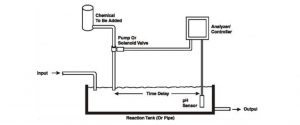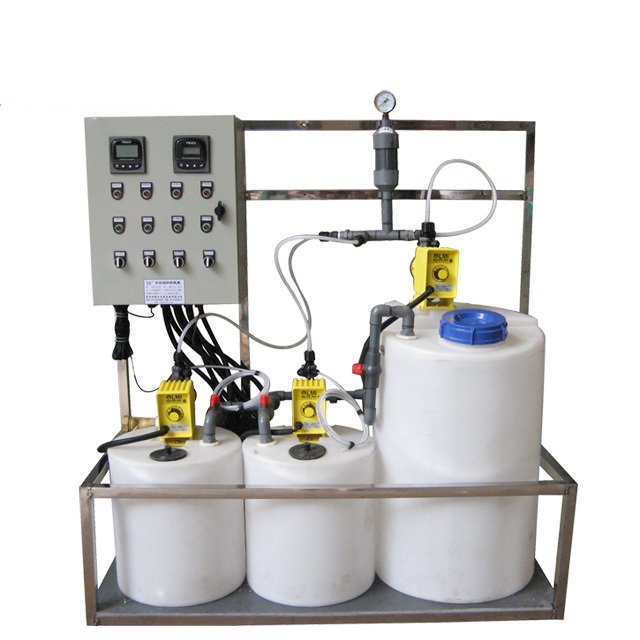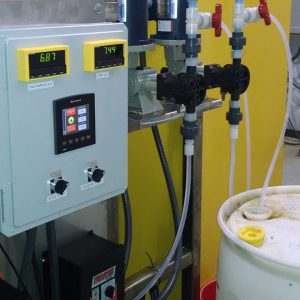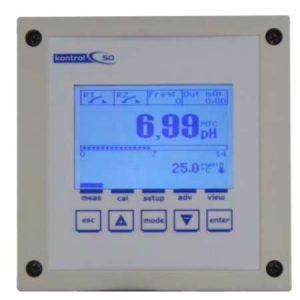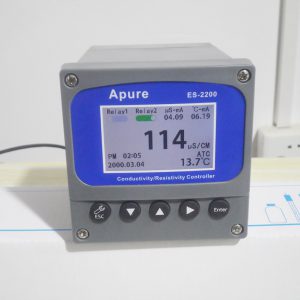Description
Automatic online PH Control System
ENGINEERIC is the supplier and manufacturer of PH Control Systems in Pakistan. Introduction Different types of applications require different pH operating principles of each. It is intended to help control systems. This technical bulletin describes six-match applications with the most suitable pH control basic types of pH control systems and outlines the system.
Control System A: Batch Processing (Discontinuous Input)
This type of PH control system uses an on/off relay controller for “batch” processing. The system operates as follows:
1. Process solution is pumped into a tank until full.
2. Agitation or mixing begins and chemical is added until the desired pH is reached. The relay controller switches the chemical addition pump (or solenoid valve) on/off.
3. Process then flows out or is pumped out of the tank. In this control system, it is desirable to employ some type of level sensing system to signal when the tank is full and empty and to lock out the mixer and pH control (PH Control System) when the solution is not at the proper level.
Also, if mixing is poor, a repeat-cycle timer is recommended. The resulting off time of the cycle provides the system extra time to mix and reduce any eventual pH overshoot.
When sizing the final control element, note that there will be some delay between adding chemicals and sensing the resulting pH change. If the final control element is oversized, the system will have unacceptable overshoot. The faster the mixing is, the less the delay and/or overshoot will be.
This simple pH control system has one disadvantage—it does not easily handle a continuous flowing process.
Control System B: Batch Processing (Continuous Input)
This type of PH control system is very similar to System A but allows for continuous input. In batch processing applications with continuous input, an on/off relay controller with latching or Deadband is required. The headband will hold the final control element on for a longer time, resulting in smooth operation without rapid cycling.
Control System B does not require as much level control and monitoring as System A, since the reaction tank outlet can be sized large enough and placed in the tank wall to make tank overflow unlikely.
The final control element can be a pump or an on/off valve. The sizing of the final control element is complicated and depends on many factors. This is one situation where a titration curve can be very useful.
In many cases, it may be necessary to use two final control elements, each one delivering a different amount of chemical and having a different setpoint. For example, one valve may deliver 1 GPM (gallon per minute) of caustic below 3 pH and the other may deliver 0.1 GPM of caustic below 4 pH.
Good mixing is very important in these types of systems and the mixer or agitation method should not be undersized. The retention time of the system (tank volume divided by GPM in-flow) should be greater than 10 minutes.
If it is much longer, a repeat-cycle timer may reduce overshoot. This type of control system can be fairly accurate, but it generally does not produce smooth outputs. The pH (PH Control System) will tend to cycle between levels.
Control System C: Batch Processing (Continuous Input and Delay Time)
This type of control system uses a proportional gain controller with time proportioning (% cycle) output for applications like those of System B, except that the delay time between chemical addiction and sense is at least one minute. This type of situation may occur where the solution flows through a long tank, a trough, or a series of tanks.
The time proportioning (% cycle) output is a switch closure that activates a solenoid valve or pump. The controller’s analog output is fed to an electronic “percent of cycle timer” to electrically adjust the on-time from 0 to 100%. The time base of the cycle timer is electrically adjustable from a few seconds to a few minutes.
PH Control System
The chemical delivery to the system is through a series of “chemical shots.” If the system is not receiving enough chemicals, the controller output will affect the cycle timer to lengthen the on-time and shorten the off-time.
The cycle time should usually be less than the delay the sensor does not measure large pH variations. The time of the system, so that a series of shots are in the final control element, should be sized so that it cannot tank and gradually mix.
By the time chemical deliver more than five times the amount of chemical reaches the sensor, it should be mixed enough so that required at the maximum system load.
